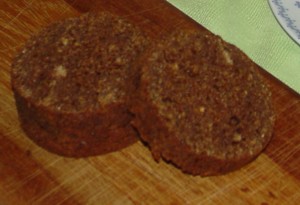

BROWN BREAD
 To some steamed brown bread immediately comes to mind. A look at recipes books from 1830 to 1946 and you find the name brown bread applied in numerous ways. Examples: Raised Brown Bread, Sour Milk Brown Bread, Brown Bread #1, #2, #3, Boston Brown Bread, Eastern Brown Bread, Indian Bread, New England Brown Bread, Rye and Corn.
To some steamed brown bread immediately comes to mind. A look at recipes books from 1830 to 1946 and you find the name brown bread applied in numerous ways. Examples: Raised Brown Bread, Sour Milk Brown Bread, Brown Bread #1, #2, #3, Boston Brown Bread, Eastern Brown Bread, Indian Bread, New England Brown Bread, Rye and Corn.
A few recipes were for yeast raised and baked brown breads. Most recipes were for boiled or steamed brown breads. Each one was a little different. Variations shifted between sour milk, sweet milk and a combination of the two types of milk. Molasses was the main sweetener with a couple of exceptions. Geographical areas favored different combinations of flours.
So what is Brown Bread? A type of bread made of corn, molasses, and rye and/or graham flours. Depending upon where you lived determined what combination of flour was used.
Geographical preferences:
Isle of Shoals (NH) favored – rye and corn
Boston favored – rye, corn, and graham
Central Massachusetts (Deerfield) – rye and corn without sweetener
“Eastern Brown Bread” a recipe listed in the Buckeye Cookbook 1883 from the Ohio Valley area lists corn and rye or graham, showing some areas favored one or another of the two flours.
In all the brown bread recipes listed there was one ingredient that did not show up. That was white flour. For a recipe to be given the name Brown Bread, it could not contain white flour. By the 1950’s that started to change. Local preferences gave way to modern tastes and white flour was added to most regional recipes. Another change was wheat flour replaced graham flour.
Isle of Shoals (New Hampshire) Brown Bread Recipe - from the Appledore Cookbook (1877)
Author M. Parloa tested all the recipes in this book before going to print and made occasional comments.
Brown Bread No. 3
“Nice. One pint of sour milk, half a cup of molasses, one teaspoonful saleratus, one tablespoonful of salt, half Indian [cornmeal] and half rye meal enough to make a stiff batter; lard the baking-tin well, and turn in the mixture. Steam five hours. I will say here, that you cannot steam brown bread too much; but do not steam it less than five hours.”
Boston Brown Bread - from The Boston Cooking-School Cook Book by Fannie Merritt Farmer circa 1920
1 cup rye meal
1 cup granulated corn meal
1 cup Graham flour
2 cups sour milk, or 1 ¾ cups sweet milk or water
¾ tablespoon soda
1 teaspoon salt
¾ cup molasses
Mix and sift dry ingredients, add molasses and milk, stir until well mixed, turn into a well-buttered mould, and steam three and one-half hours.
This is a later recipe than the Appledore recipe. It calls for soda instead of saleratus.
Brown Bread Brewis was a recipe for using up dry brown bread. It called for breaking up the brown bread with or without a small amount of stale white bread, cooking the crumbled bread in butter and milk or water in a frying pan until soft. One recipe said to salt to taste. Another recipe suggested serving with cream and sugar. This would be served for breakfast or supper.
Modern version of Steamed Boston Brown Bread
1 cup cornmeal
1 cup whole wheat flour (Rye & Graham flour are available in some food stores)
1 cup white flour
1¾ cups sweet milk (or 1½ c. sour milk; to sour milk use 1 Tbsp plus 2 teas. Vinegar to room temperature milk to equal 1½ cups)
½ teaspoon salt
1 teaspoon soda
1 cup molasses
½ cup raisins, optional
Sift dry ingredients together. Add milk and molasses and stir. Add raisins. Batter will be liquidity not stiff. Pour into greased cans or canning jars or a large mould or baking dish to no more than 1/2 to 2/3 full. It will raise considerably. Cover with wax paper and tie down (I use elastics to keep wax paper in place), this is to keep moisture from boiling water off the bread. Place cans, jars or mould on a rack in a deep pan. Fill pan with cold water up to 1 inch high on cans. Boil for 3 hours at a low boil. Check to make sure water does not boil a way if so add more boiling water. Remove from cans or jars soon after coming out and place on rack to dry and cool.
